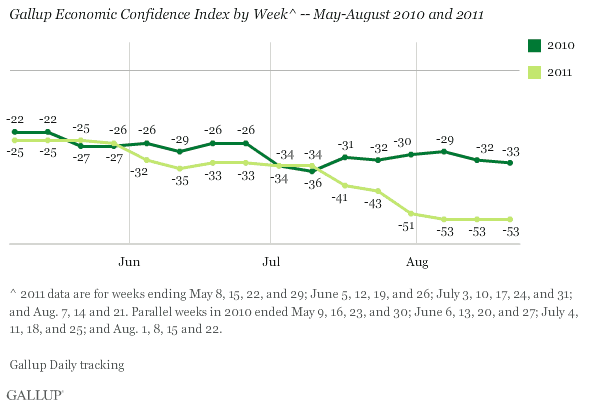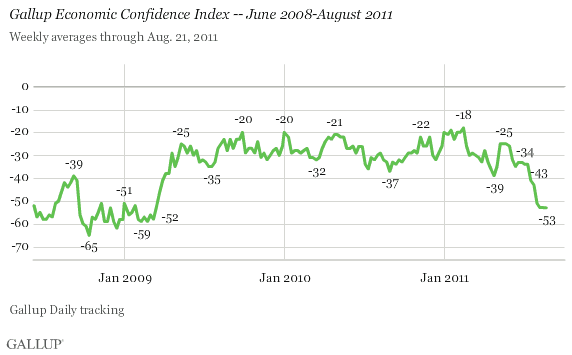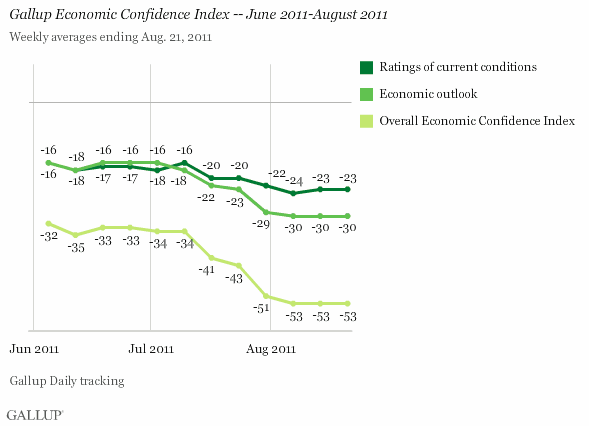PRINCETON, NJ -- Americans' confidence in the economy is weak but stable after ratcheting sharply downward in July. The Gallup Economic Confidence Index registered -53 for the week of Aug. 15-21, identical to the first two weeks of August but well below the -34 of July 4-10 and 20 percentage points below where it stood a year ago.

Gallup's recent confidence readings are the lowest since March 2009, when consumer attitudes had barely started to recover from the deep lows recorded during the 2008 Wall Street crisis. At that time, confidence was in the mid- to low 50s, not much improved from the -65 recorded in October 2008. Confidence remained negative but fluctuated in a fairly narrow range between -18 and -39 from April 2009 through early July 2011.

Americans' Economic Outlook Down Especially Sharply
The 19-point decline in the Economic Confidence Index since early July to -53 is the result of a 7-point drop in Americans' positive rating of current economic conditions and a 12-point drop in their optimism about the direction of the economy.
Both of these measures dipped slightly in mid-July, but then fell by even larger amounts in the last week of July. This occurred as Congress engaged in its final negotiations over legislation to raise the federal debt ceiling, finally passed on Aug. 2.

Implications
Gallup reported a notable decline in Americans' economic confidence in mid-July coincident with political wrangling in Washington over the nation's budget and the concomitant bleak discussion about the nation's debt obligations. Confidence tumbled further in late July as media attention to the debt ceiling issue intensified, and it has since remained low, perhaps owing to the Aug. 5 downgrading of the nation's credit rating by Standard and Poor's and subsequent volatility in the stock market.
Without further economic or political shocks, today's fragile consumer attitudes could rebound some in the coming weeks, although perhaps not as quickly as they fell. One risk is that the markets will erroneously interpret the Conference Board's August Consumer Confidence Index as new information when it is reported next week. Given that the Conference Board's monthly interviews are skewed toward the beginning of each month, any drop in that index will reflect the changes in consumer attitudes between early July and early August that Gallup already detected and first reported last month.
Gallup analysis suggests the Conference Board's August index could show a drop of more than 10 points and thus come within 20 points of that trend line's all-time record low. However, if the markets are spooked by this and the Dow tumbles as a result, consumer confidence could be driven further down as well.
To maintain perspective, retailers, stock traders, and others who follow consumer attitudes should perhaps focus more on the recent stabilizing of public confidence in the economy in August, albeit at a low threshold, and less on the steep decline in July that brought it to this point.
Gallup.com reports results from these indexes in daily, weekly, and monthly averages and in Gallup.com stories. Complete trend data are always available to view and export in the following charts:
Daily: Employment, Economic Confidence and Job Creation, Consumer Spending
Weekly: Employment, Economic Confidence, Job Creation, Consumer Spending
Read more about Gallup's economic measures.
View our economic release schedule.
Survey Methods
Results are based on telephone interviews conducted as part of Gallup Daily tracking Aug. 14-21, 2011, with a random sample of 3,475 adults, aged 18 and older, living in all 50 U.S. states and the District of Columbia.
For results based on the total sample of national adults, one can say with 95% confidence that the maximum margin of sampling error is ±2 percentage points.
Interviews are conducted with respondents on landline telephones and cellular phones, with interviews conducted in Spanish for respondents who are primarily Spanish-speaking. Each sample includes a minimum quota of 400 cell phone respondents and 600 landline respondents per 1,000 national adults, with additional minimum quotas among landline respondents by region. Landline telephone numbers are chosen at random among listed telephone numbers. Cell phone numbers are selected using random-digit-dial methods. Landline respondents are chosen at random within each household on the basis of which member had the most recent birthday.
Samples are weighted by gender, age, race, Hispanic ethnicity, education, region, adults in the household, and phone status (cell phone only/landline only/both, cell phone mostly, and having an unlisted landline number). Demographic weighting targets are based on the March 2010 Current Population Survey figures for the aged 18 and older non-institutionalized population living in U.S. telephone households. All reported margins of sampling error include the computed design effects for weighting and sample design.
In addition to sampling error, question wording and practical difficulties in conducting surveys can introduce error or bias into the findings of public opinion polls.
For more details on Gallup's polling methodology, visit www.gallup.com.
